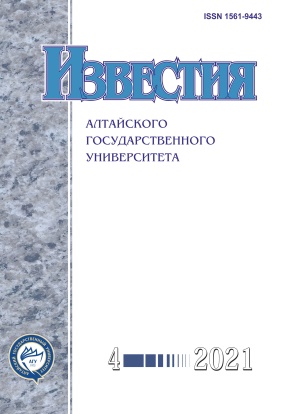Computer Simulation of the Semiconductor Nanoelectromechanical Systems AIIBIVAs2 Stability after Attosecond Impulse Exposure
УДК 541.1
Abstract
The article deals with computer modeling of responses of multicomponent semiconductor nanoelectromechanical systems of arsenides to an attosecond radiation pulse at cryogenic (T1=77 K) and standard temperatures (T2=298 K). Kinetic curves of relaxation processes in ternary semiconductor nanolayers CdSiAs2, CdGeAs2, ZnSiAs2, ZnGeAs2, and nanolayers of variable composition CdSi1-xGex As2, ZnSi1-xGexAs2, Cd1-xZnxSiAs2 и Cd1-xZnxGeAs2 are obtained. This research reveals the differences in the average relaxation energy of nanolayers that depend on temperature and the amplitudes of energy fluctuations, and the time of reaching the plateau. A comparison with relaxation processes taking place at absolute zero temperatures is demonstrated. The radial distribution functions of atoms in the system before and after relaxation processes caused by impulsive action on the system of atoms in the semiconductor layer are considered. The modification of the peaks corresponding to the coordination spheres of atomic distribution depending on the composition of the nanolayer is described. The regularities of relaxation changes of the first order coordination spheres, as well as the regularities of relaxation destructions of the second and the third order coordination spheres at cryogenic and standard temperatures are revealed.
Downloads
Metrics
References
Verma A. S. Thermal properties of chalcopyrite semiconductors // Philosophical Magazine. 2009. Vol. 89. № 2.
Jiawei L., Shifu Z., Beijun Z. XPS Analysis and Determination of Surface Damage Layer of CdGeAs2 Single Crystal // Rare Metal Materials and Engineering. 2015. Vol. 44. № 4.
AchantaV.G. Surface waves at metal-dielectric interfaces: Material science perspective // Surface waves at metal-dielectric interfaces: Material science perspective. 2020. Vol. 5.
Koroleva L.I., Zashchirinskii D.M., Khapaeva T.M. Manganese-doped CdGeAs2, ZnGeAs2 and ZnSiAs2 chalcopyrites: A new materials for spintronics // Journal of magnetism and magnetic materials. 2011. Vol. 323. No. 23.
Novotortsev V.M., Palkina K.K., Mikhailov S.G. Synthesis and Structure of Mn-Doped CdGeAs2 Single Crystals // Inorg Mater. 2005. Vol. 41. № 5.
Demin R.V., Koroleva L.I., Marenkin S.F., et al. Mn doped CdGeAs2 Chalcopyrite: A New Ferromagnet with a Curie Temperature of 355 K // XIX Mezhdunarodnaya shkola-seminar po novym magnitnym materialam mikroelekt-roniki (XIX Int. Workshop on New Magnetic Materials for Microelectronics). M., 2004.
Volkov D.A., Terenteva Y.V., Beznosyuk S.A. Attosecond nanotechnology: Quantum dots of nanoelectromechanical systems of CuInxGa1-xS2 compounds // Bulletin of the university of Karaganda-chemistry. 2019. Vol. 95. № 3.
Терентьева Ю.В., Безносюк С.А., Волков Д.А., Гайдукова А.А., Лысенко А.С. Компьютерное моделирование устойчивости нанослоев селенида цинка, легированных железом, подвергшихся импульсному воздействию // Фундаментальные проблемы современного материаловедения. 2020. Т. 17. № 3.
Терентьева Ю.В., Безносюк С.А., Волков Д.А. Компьютерное моделирование устойчивости легированных марганцем морфологических модификаций квантовых НЭМС диарсенида цинка-кремния // Фундаментальные проблемы современного материаловедения. 2020. Т. 17. № 4.
Zawilski K.T., Schunemann P.G., Pollak T.M. Glass formation and optical properties of CdGeAs2 // Journal of Crystal Growth. 2008. Vol. 310. № 7-9.
Boukabrine F., Chiker F., Khachai H. Ab initio calculation of ZnSiAs2 and CdSiAs2 semiconductor compounds // Physica B: Condensed Matter. 2011. Vol. 406. № 2.
Xu B., Han H., Sun J. The structural, electronic and optical properties of the chalcopyrite semiconductor ZnSiAs2 // Physica B: Condensed Matter. 2009. Vol. 404. № 8-11.
Copyright (c) 2021 Анастасия Александровна Гайдукова , Юлия Владимировна Терентьева , Сергей Александрович Безносюк

This work is licensed under a Creative Commons Attribution 4.0 International License.
Izvestiya of Altai State University is a golden publisher, as we allow self-archiving, but most importantly we are fully transparent about your rights.
Authors may present and discuss their findings ahead of publication: at biological or scientific conferences, on preprint servers, in public databases, and in blogs, wikis, tweets, and other informal communication channels.
Izvestiya of Altai State University allows authors to deposit manuscripts (currently under review or those for intended submission to Izvestiya of Altai State University) in non-commercial, pre-print servers such as ArXiv.
Authors who publish with this journal agree to the following terms:
- Authors retain copyright and grant the journal right of first publication with the work simultaneously licensed under a Creative Commons Attribution License (CC BY 4.0) that allows others to share the work with an acknowledgement of the work's authorship and initial publication in this journal.
- Authors are able to enter into separate, additional contractual arrangements for the non-exclusive distribution of the journal's published version of the work (e.g., post it to an institutional repository or publish it in a book), with an acknowledgement of its initial publication in this journal.
- Authors are permitted and encouraged to post their work online (e.g., in institutional repositories or on their website) prior to and during the submission process, as it can lead to productive exchanges, as well as earlier and greater citation of published work (See The Effect of Open Access).








